Get Away from It All in Burgundy
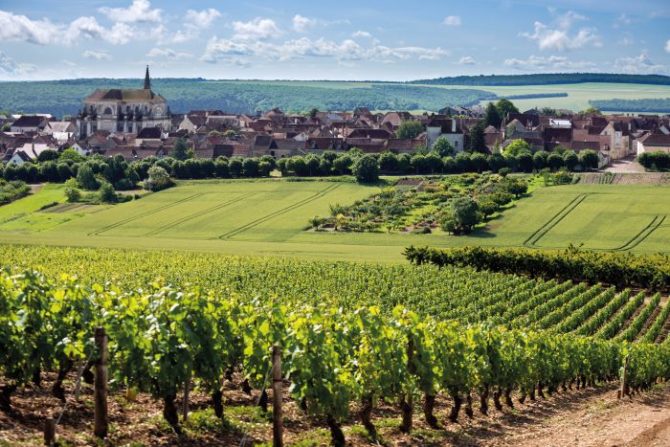
From little-known mountains to a valley of waterfalls and expansive forests to vast vineyards, Burgundy is the perfect place for post pandemic travels away from the crowds – and so much more besides. Caroline Harrap takes us on a tour
Think of Burgundy and, for many people, it’s the famous wines, hearty boeuf bourguignon and tales of dashing dukes from the region’s rich history that come to mind. Oh, and mustard, of course.
While these are certainly key components of the area’s identity, an aspect that is sometimes overlooked is the great natural beauty of Burgundy – with everything from mountains and forests to rivers and lakes to waterfalls. In fact, the wider region of Bourgogne-Franche-Comté is the fifth most wooded area of France – with forests and vines covering more than a third of the land.
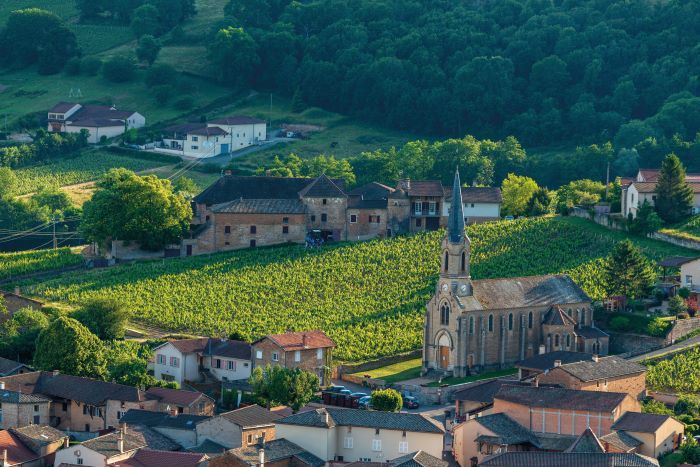
The picturesque surrounds of Vergisson in southern Burgundy © BIVB, Michel Joly
Coupled with the sheer amount of green open space – and the lack of crowds, to boot – and it all adds up to a very alluring proposition for a post-pandemic trip. “Just imagine: thousands of kilometres of hiking and cycling trails, gentle mountains, lakes and forests, legendary vines and centuries-old know-how,” says president of the Regional Tourism Board, Loïc Niepceron. “Following the events of the past year or so, the region of Burgundy is the ideal environment for healthy, revitalising and sustainable travel.”
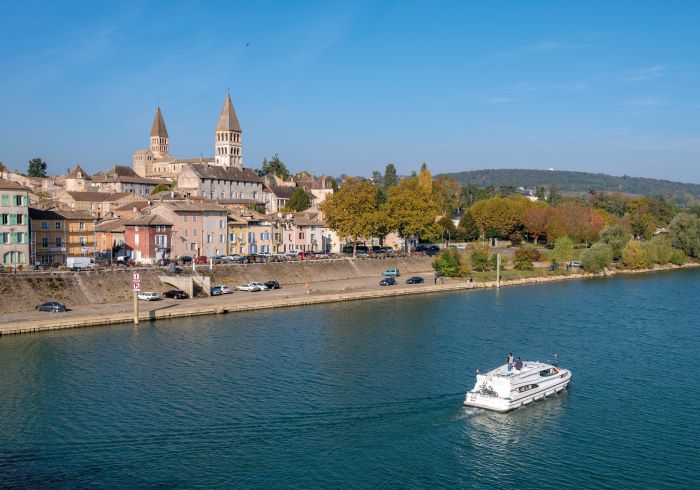
Exploring by boat is a great way to see the sights such as here at Tournus © Alan Doire, Bourgogne-Franche-Comté Tourisme
Certainly, for those craving the great outdoors, where better to start than the Regional Natural Park at the heart of Burgundy, the Morvan, spanning more than 1,000 square miles. For those who haven’t visited Bourgogne before, to use its proper name, this historical region takes in four départements – Côte-d’Or, Nièvre, Saône-et-Loire and Yonne – and each has a foot in the park.
NATURAL WONDERS
A true natural paradise, the Morvan also has the distinction of being home to the closest mountain range to Paris. Small but perfectly formed, this granite massif peaks at 900m. Featuring pristine forests and large lakes, the park has a unique fauna and flora with many species of mammals and birds.
Another undoubted highlight here is the Canche Gorges, where streams wend their way down a valley as tiny waterfalls, carving out mysterious formations. Then there’s the 10m-high cascade of Gouloux to the north. Wherever you choose, it’s well worth pulling on your walking boots and exploring further.
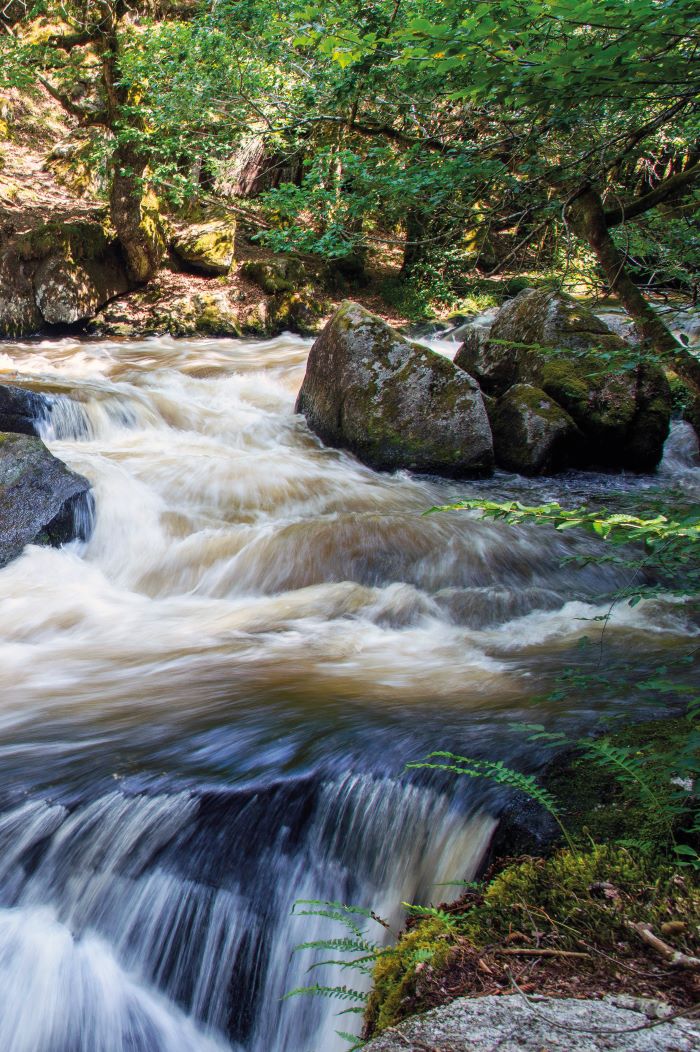
The Chalaux river wending its way through the Morvan park © Alain Doire, Bourgogne-Franche-Comté Tourisme
“Located in the heart of the French countryside, the Morvan park is the perfect destination for any outdoors enthusiast,” says Manon Nectoux, the European operations manager for AllTrails, which offers some 40 routes through the park. “It’s a great place to explore by foot, on a bike, on horseback or with a paddle. From short walks to multi-day hikes, there really is something for everyone.”
Of course, Burgundy is not only the perfect place to reconnect with nature after months of confinement, but so much more besides. For a start, there’s the region’s wealth of history, taking in everything from prehistoric caves and ancient abbeys to centuries-old châteaux. Once a powerful duchy, which rivalled France itself in the late Middle Ages, the dukes of Burgundy left behind a legacy that very much endures to this day.
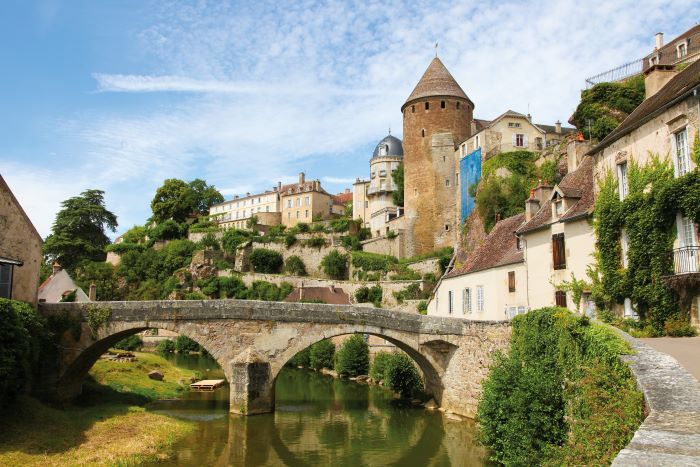
The castle and Pont Pinard over the river Armançon in Semur-en-Auxois © shutterstock
HERITAGE HOTSPOTS
The region can also lay claim to several UNESCO World Heritage Sites, the greatest concentration of Romanesque architecture in the country and one of the largest networks of navigable waterways, with more than 1,200km of canals and rivers. Then, of course, there’s the legendary gastronomy – with four Michelin-starred restaurants in Dijon alone – and the world-famous wines. What is more, it’s less than two hours on the train from Paris – which means if you’re on an early Eurostar, you could be enjoying a glass of chilled Chablis by lunchtime. Assuming, that is, you’re not looking for a 2021 vintage, in which case you might be out of luck. As many readers will know, the vineyards here are facing one of the most challenging times in their history after a series of devastating frosts struck late in the season. While the sight of lamps being lit across the land made for some striking images, it was a matter of survival for many vineyards.
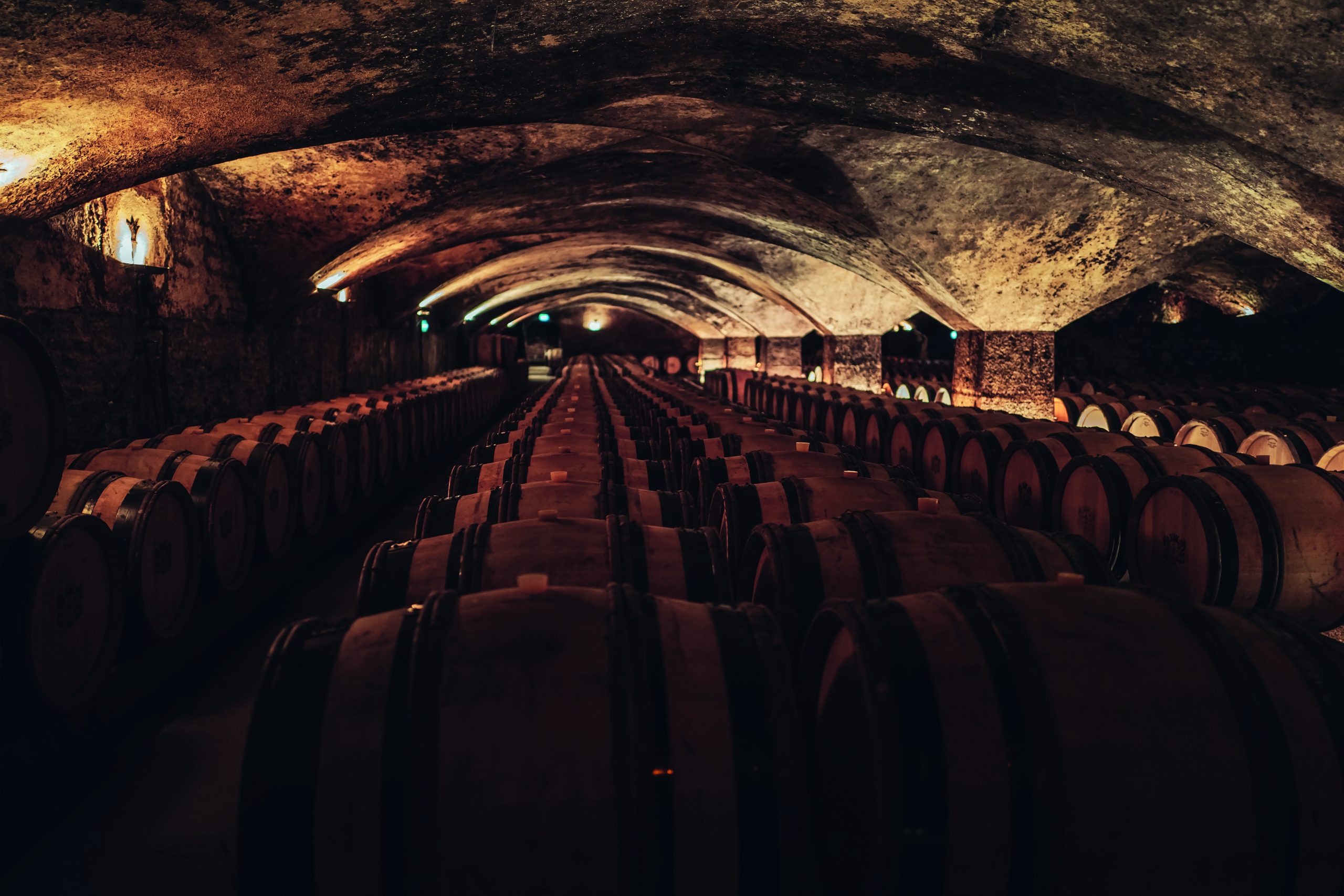
A wine cellar in Beaune; the region produces many fine wines; bustling terrasses in Dijon © shutterstock
“Each year in Chablis, we are particularly exposed to the spring frosts, so we are accustomed to fighting against them,” says Frédéric Gueguen, who owns the 26-hectare wine estate, Domaine Gueguen, with his wife Céline. “However, this was a very long period of cold weather, over two weeks, preceded by some unseasonably warm weather – the worst combination. As a result, we had eight sleepless nights – and even snow on one of them.
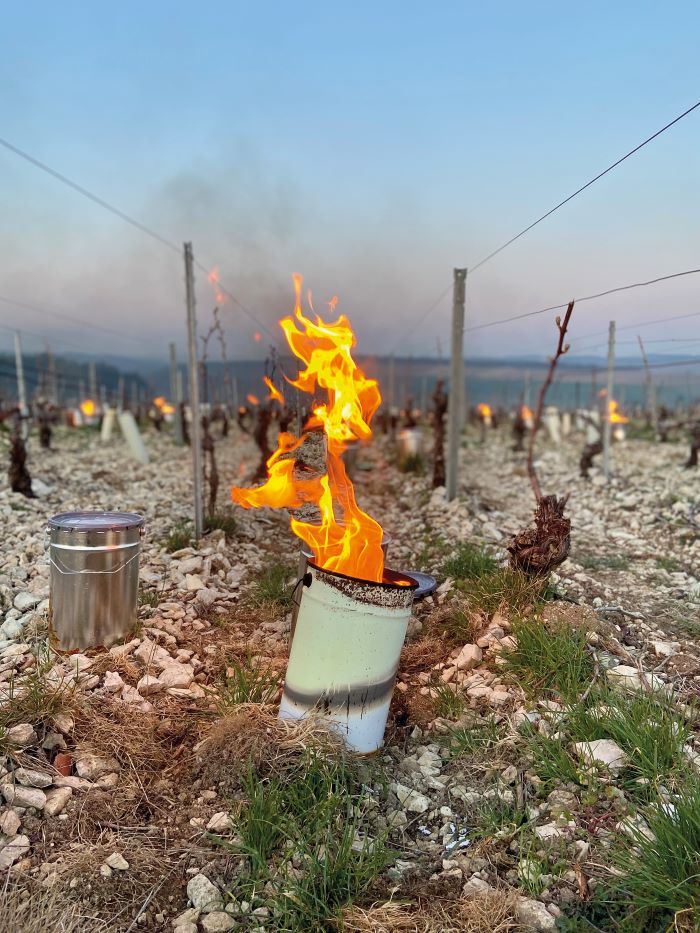
Lamps being lit at the vineyards of Domaine Gueguen to protect the vines from the frosts © Domaine Gueguen
“The landscape looked absolutely beautiful, but it was so frightening, too, fighting to save not only the work of a year but of our lives. Now we wait to see…”
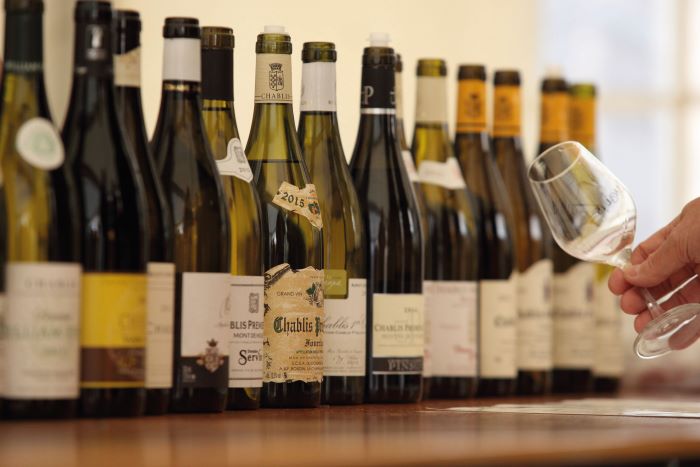
Some of the many fine wines produced in Burgundy © BIVB, Claude Blot
One of the oldest wine-growing regions in the country, there is evidence of vines being planted here in the second century. Today, Burgundy is home to two of the world’s best-known grape varieties, Chardonnay and Pinot Noir, and some of the most famous names in wine. In fact, so revered is its terroir that a large stretch to the south of Dijon has UNESCO World Heritage status. A visit to the Burgundy wine capital, the medieval town of Beaune, is certainly a must for any self respecting oenophile. The centre of the wine trade since the 18th century, it has one of the largest networks of cellars in the world. Then there’s Beaune’s popular wine museum, the regular wine festivals and the renowned wine auction held at the iconic Hospices de Beaune, a 15th-century architectural marvel. In addition, the excellent École des Vins de Bourgogne runs introductory sessions and can arrange tastings at the vineyards.
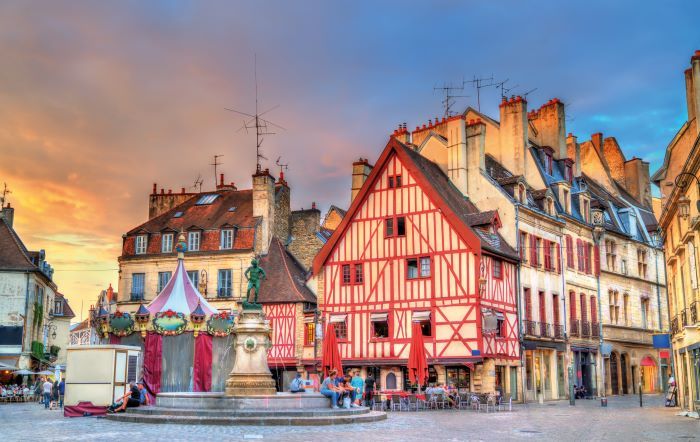
Traditional buildings in historic Dijon © shutterstock
NEW HORIZONS
Coming soon, the region is set to open a major attraction dedicated to the area’s wine heritage. Due to be ready in 2022/23, the Cité des Vins et des Climats de Bourgogne will be made up of three wine tourism venues in the key areas of Beaune, Chablis and Mâcon. Each an attraction in its own right, they will offer workshops, exhibitions, conferences and more.
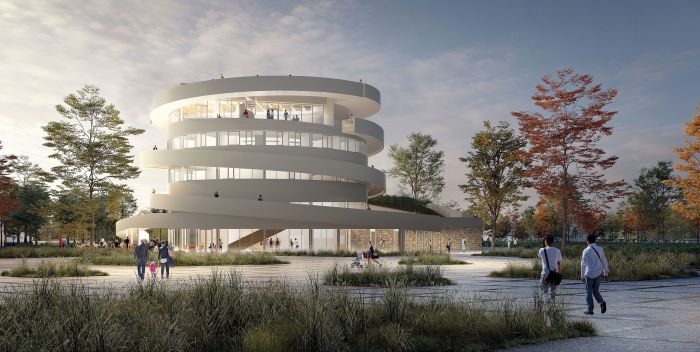
The new Cite des Vins will be spread over three sites, including this one at Beaun © BIVB, Siz-Ix Architectes
“The Cité des Vins will be a must-see site in the future,” says spokesperson Chloé Butet. “Through its network of three locations, we invite visitors to discover all the region’s appellations and their terroir. With around 180,000 visitors expected in the first year, the Cité is set to be a very important new addition to the region.”
In the meantime, there’s no shortage of other places to put on your Burgundy bucket list. Top of many people’s itinerary is the historic capital, Dijon, whose centre is listed by UNESCO as part of the area’s wider wine heritage. Offering a rich architecture dating back to medieval times, the star of the show is the imposing Palace of the Dukes – home to two of their tombs – and now the setting for the Musée des Beaux-Arts.
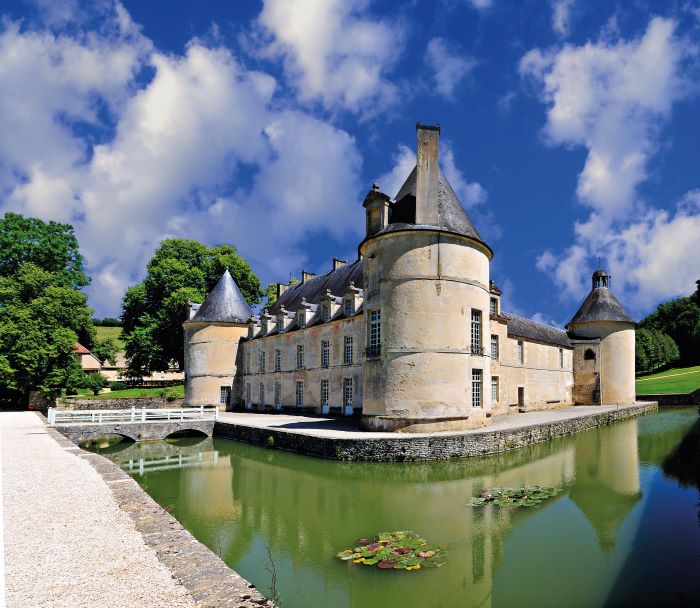
The Château de Bussy-Rabutin © shutterstock
Elsewhere, the legacy of the dukes lives on in the celebrated châteaux dotted across the region. Among the best are Bussy-Rabutin, Ancy-le-Franc, Couches, Pierre-de-Bresse and Brancion. If you’ve only time for one, however, make it Châteauneuf-en-Auxois, where the village is designated one of Les Plus Beaux and is in the running for France’s favourite. Sometimes billed as a ‘miniature Carcassonne’, the impressive castle here is beautifully preserved – and the medieval attic space is unique in France.
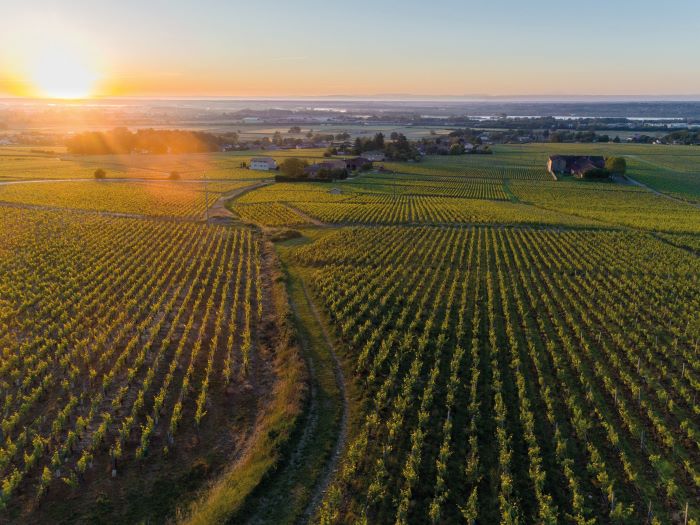
The vineyards of Le Clos Reyssie, near Chaintré, south of Mâcon © BIVB, Michel Joly
Burgundy can also lay claim to some of the most renowned Romanesque architecture in Europe. From the abbeys of Cluny, Fontenay and Saint-Philibert to the basilicas of Vézelay and Paray-le-Monial and the cathedral of Saint-Étienne d’Auxerre, each has its own unique charm. Then there’s the area’s extraordinary prehistoric history, such as at Azé, with its subterranean landscape featuring a river and waterfall, where they recently made an exciting discovery.
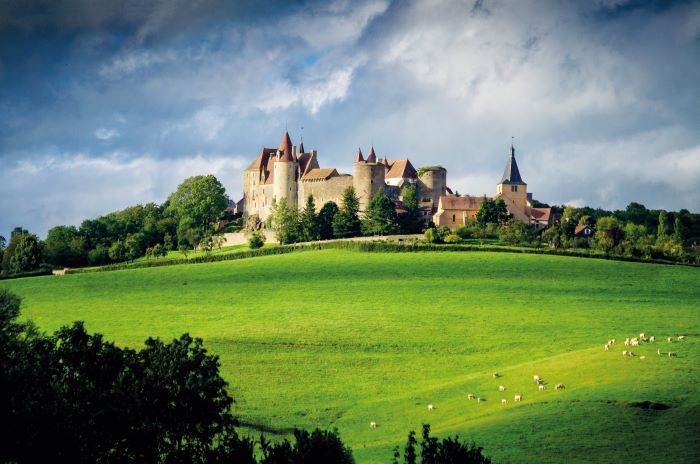
Chateauneuf-en-Auxois © shutterstock
HIDDEN ATTRACTIONS
“After decades of removing clay that was plugging a gallery, a new room was discovered on February 2, 2020,” says Maëlle Dulong, tourism development officer at Grottes d’Azé. “We named it the ‘palindrome room’ because the date, 02/02/2020, can be read either way. The cavity contains different types of concretions, including colourful concentric circles. Situated at the end of a narrow tunnel, this room and one next to it are sadly not accessible to the public. However, you can still come and discover the mysterious world here by visiting two caves that are open. The first one reveals the geological wonders of Azé, the river that tirelessly carves the rock and the natural colours that surprise the eye, and the second bears witness to one of the oldest human occupations in Burgundy.”
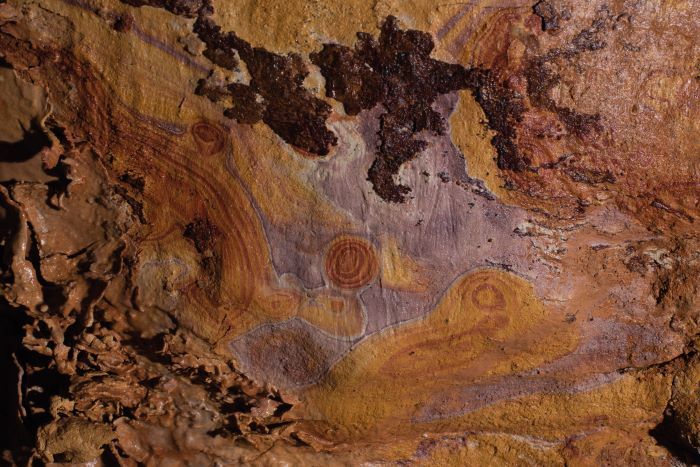
There was great excitement at Grottes d’Azé recently when two new rooms were discovered © Serge Caillault, Speleo Magazine Grottes d’Azé
While it’s not every day that a new cave is discovered, the region has a few other surprises up its sleeve too. From forest-bathing sessions in the Côte-d’Or to walking with raptors at Bibracte, or visiting the childhood home of famed French writer Colette in Saint-Sauveur-en-Puisaye, you don’t have to stray far off the tourist trail to find quirky, interesting and unexpected attractions.
New for this year, the first 100 per cent vintage amusement park in Europe, Vintageland, is set to open near Beaune. As well as rides and attractions from the 1950s to the 1970s, there will be arcade games, collectors’ vehicles, vintage dealers, film screenings, dances and more. Dressing according to the period is also recommended.
The iconic Hospices de Beaune with its famous roof tiles © Alain Doire, Bourgogne-Franche-Comté Tourisme
Another place not to be missed is Guédelon, where a team of master-builders is constructing a medieval castle from scratch. Furthermore, they are using only authentic methods, tools and original materials. And that’s not to mention the fantastical folly of Opus Gothique, in the nearby Morvan park, which is being constructed by a 94-year-old, no less, aided by a team of volunteers.
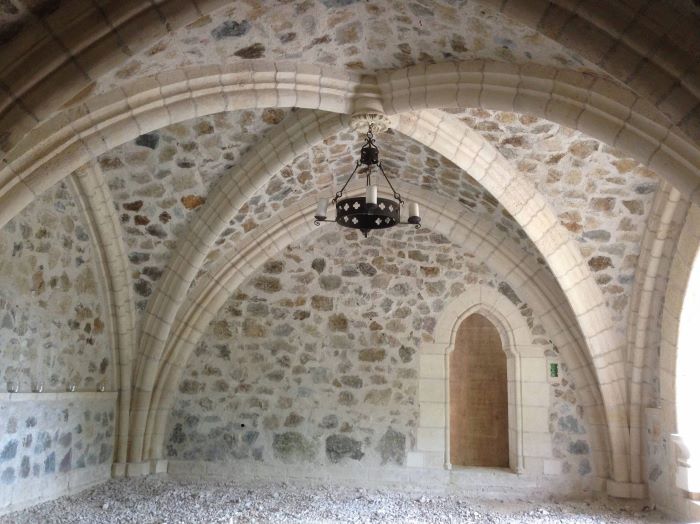
Construction work at Opus Gothique is well underway © Opus Gothique
“It’s not a house, nor a castle, nor a church but a work of art – an architectural fantasy constructed entirely using 13th-century building techniques,” says Donald Russell, who spent 35 years as a palaeontologist at the Museum of Natural History in Paris. “At the heart of it all is a heritage and human adventure. As well as welcoming volunteers, we also invite the public during special open days.”
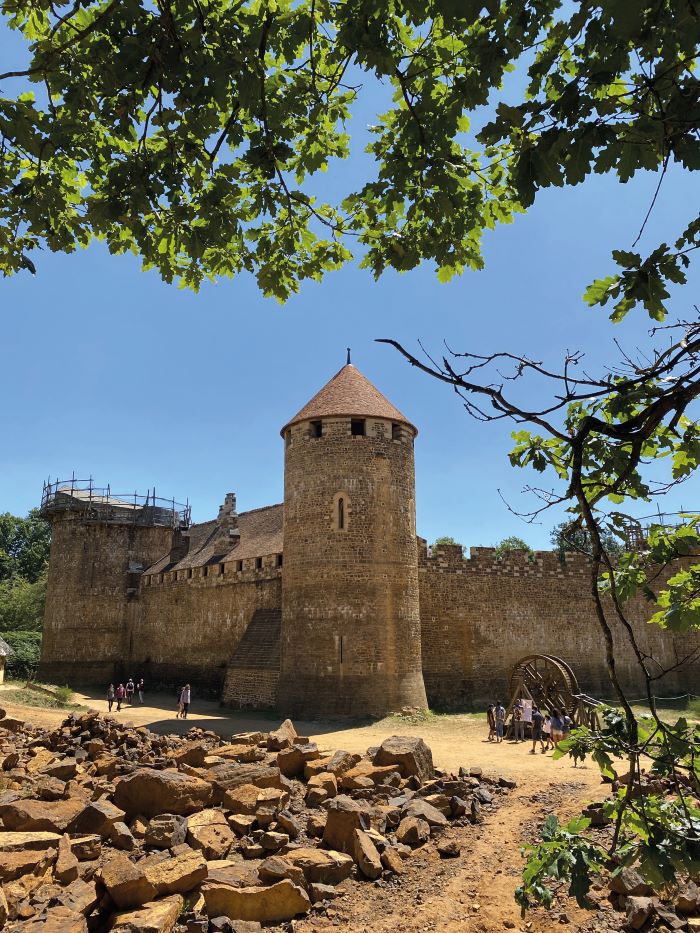
The ‘medieval’ castle of Guédelon where you can witness history in the making © Maud Humbert, Bourgogne-Franche-Comté Tourisme
Whatever it is that draws you to Burgundy, there are myriad ways of exploring this diverse region – from hiking and horse-riding to boating and balloon rides. However, cycling in particular seems to be big news here at the moment – boosted perhaps by the ever-growing number of trails. Along with neighbouring Franche-Comté, there are now some 2,900km of cycle routes, with something for all levels.
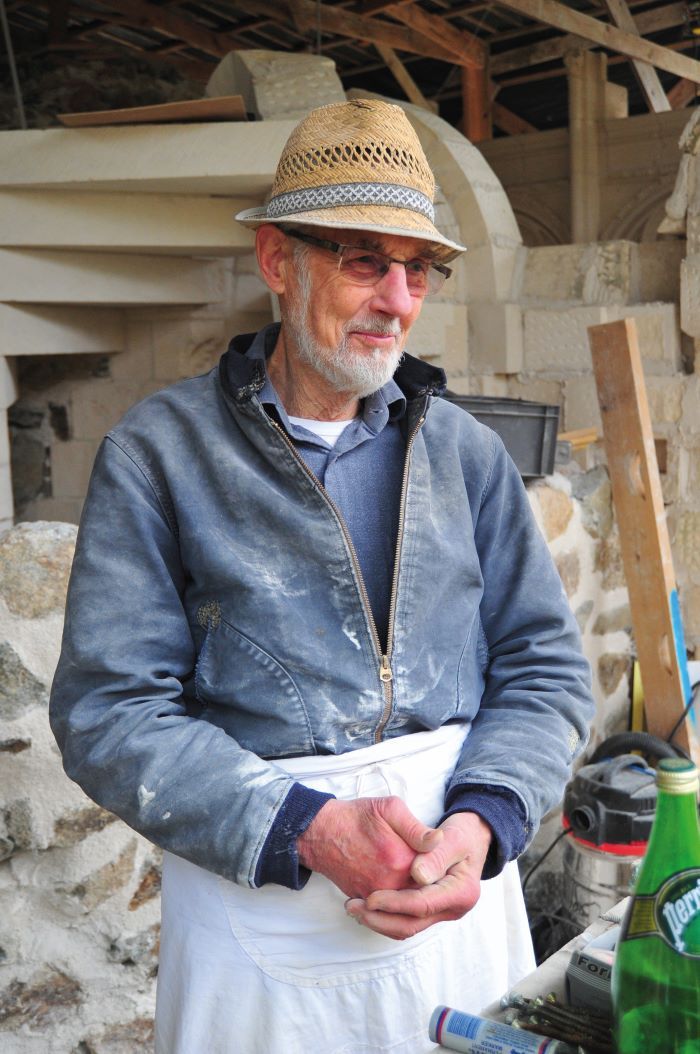
At age 94, Donald Russell is building his own ‘medieval’ masterpiece, Opus Gothique © Opus Gothique
A good one to begin with, though, is the Tour de Bourgogne à Vélo, which is both gentle and picturesque. Alternatively, the tougher terrain of the Grande Traversée du Morvan, which runs for 330km from Avallon to Autun, offers mountain biking through some exceptional landscapes.
BEST-KEPT SECRET
“In the Nièvre, where we are, cycling is very popular in all its forms – from road and mountain biking to the latest trend of gravel riding,” says Charles Masters, who owns the popular cycling café in Nevers, Café Vélo, with his wife Anna.
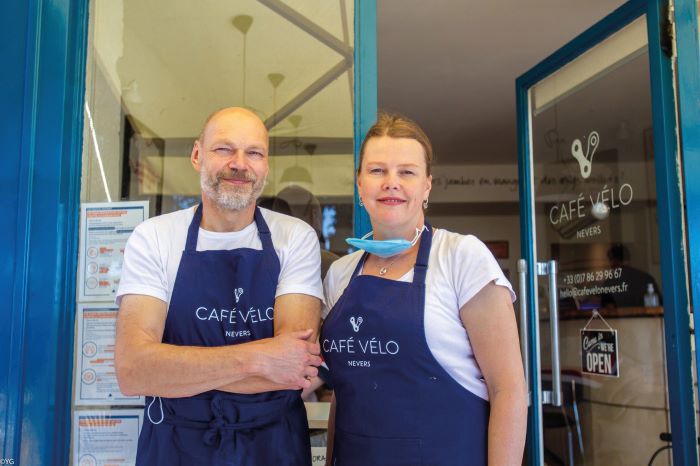
Charles and Anna at their popular cycling café in Nevers, Café Vélo, which is also well-liked by non-cyclists © Youri Gavriloff
“For a start, there’s the lovely Morvan hills and then there are the fantastic forests – and that’s not to mention the various local trails.
“For me, I think the best thing about cycling in Burgundy is the relative lack of traffic. The countryside is very pretty, and there’s a wide choice of terrain, but many places have those. The real beauty here is that you can have it almost all to yourself.” We couldn’t have put it better ourselves. But ssshh… don’t tell anyone else!
From France Today magazine
Share to: Facebook Twitter LinkedIn Email
More in Burgundy, Burgundy’s vineyard, natural wonders, world heritage sight
Leave a reply
Your email address will not be published. Required fields are marked *




REPLY